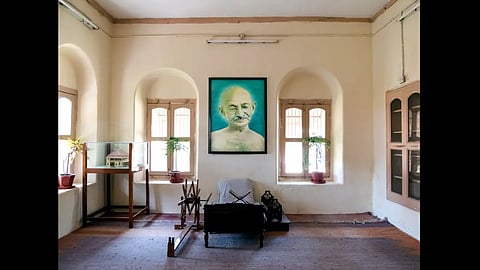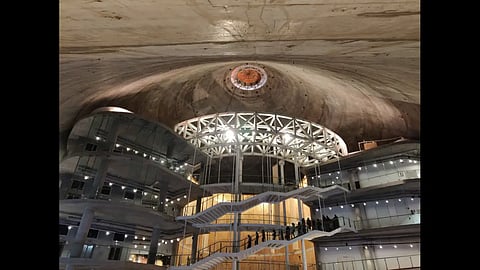Gujarat, the birthplace of Mahatma Gandhi, is synonymous with the many satyagrahas that the Father of the Nation launched to help India achieve Independence. It is where he grew up, returned from South Africa to set up his ashram, and from where he targeted the British with numerous acts of non-violent civil disobedience. Many cities in Gujarat have had a bearing on Gandhi’s life and vice versa: from Porbandar, where he was born, to Rajkot, where he spent his childhood, and from Ahmedabad, where he started many satyagrahas against the Briiish, to Dandi, where he used a fistful of salt to spark a non-violent protest. The state is some to many monuments and places that stand testimony to the Mahatma’s life, principles, and message. Here is where you can experience the state in the Mahatma’s footsteps:
Experiencing Gujarat In Gandhi’s Footsteps
The state is some to many monuments and places that stand testimony to the Mahatma’s life, principles, and message
Kochrab Ashram, Ahmedabad

Ahmedabad began to play a starring role in the Indian Independence movement when Gandhi set up the Kochrab Ashram near Paldi in 1915. Gifted by his friend Barrister Jivanlal Desai, the Satyagraha Ashram was a major centre for people to live by Gandhian ideas of satyagraha, self-sufficiency, and Swadeshi. The ashram was relocated to the banks of the Sabarmati River when Gandhi decided to do some experiments in living, with farming, animal husbandry, cow breeding, khadi and other activities.
Sabarmati Ashram, Ahmedabad
The Gandhi Ashram, located on the banks of the Sabarmati, is a must-visit when on the Gandhi trail. It was home to Gandhi from 1917 to 1930, and one of the key places from where the struggle for Indian Independence started. Gandhi launched the Dandi March to protest against the British Salt Law from here on March 12, 1930. The ashram is sectioned off into two parts, including Hriday Kunj, the cottage where the Mahatma lived and among the most popular attractions here, and the Charles Correa-designed museum that has three galleries, the Gandhi in Ahmedabad Gallery, the Painting Gallery and the My Life is My Message Gallery, and the Ashram’s library. Don’t miss sending a postcard from the in-house post box. A special ‘charkha’ stamp is used on your mail.
Gujarat Vidyapeeth, Ahmedabad
This multidisciplinary university was founded in 1920 by Mahatma Gandhi and provides a window into Gandhian ethos. The leader had started the non-cooperation movement in 1920, and wanted Indians to avoid sending their children to schools and colleges imparting English education. But he also wanted the youth to study in a premier institute. Gujarat Vidyapith, launched in October 1920 as an institute of learning and development for the youth of Gujarat, was deemed a university in 1963. Inspirational messages by the Mahatma are inscribed on walls and many students still choose to don khadi.
Dandi Kutir, Gandhinagar

Dandi Kutir is India’s largest and only museum that’s built on the life and teachings of Mahatma Gandhi. Inaugurated in 2015, Dandi Kutir is the oldest and largest museum in India to be built around the life and teachings of Mahatma Gandhi. It employs audio-visual techniques to show his early life—from his birth on October 2, 1869, to his childhood and all the way up to Kasturba and his youthful experiments. It also showcases Gandhi’s powerful idea of how people across lines of class, gender, age and community came together to assert their common right to salt.
Mahatma Gandhi Museum, Rajkot
Gandhiji passed out from Alfred High School (Kathiawar High School) in 1887. The school, which was established in October 1853 with 36 students, has since then been converted into the Mahatma Gandhi Museum. It aims to showcase Gandhi’s journey from Mohandas to Mahatma through the 39 classrooms that now display his life story and message. The 3D projection-mapping show with sound and light effects is a must-watch. The facilities include a library, the Charkha food court, and a souvenir shop.
Kaba Gandhi No Delo, Rajkot
Literally translating into Kaba Gandhi’s house, it’s located just off the busy Gheekanta Road. Karamchand Gandhi, the father of the Mahatma, was appointed the Diwan of Rajkot State and resided in this building, which was the primary family home until 1915. The house now offers a peek into the Mahatma’s early life with pictorial exhibits.
Kirti Mandir, Porbandar

The foundation of the Kirti Mandir, which stands tall as a memorial to the Father of the Nation, was laid in 1947—during Gandhi’s lifetime—by Gandhian and socialist Darbar Gopaldas Desai. The 79-feet-high structure, which symbolises Gandhi’s 79-year life span, was commissioned by industrialist Nanjibahi Kalidas Mehta. It stands around a sprawling courtyard surrounded by a photo gallery that reveals the trajectory of Gandhi’s life. The courtyard leads to the ancestral haveli of Gandhi’s great-grandfather where a swastika marks the spot where Putliba gave birth to the future leader on October 2, 1869.
Gandhi Smruti, Bhavnagar
Not many people know that Mahatma Gandhi went to university in Bhavnagar. Gandhi Smruti, a memorial to the Father of the Nation, aims to share his life’s learnings with lessons. Inaugurated in 1955, the museum has books, rare photos, and memorabilia linked to the life of Mahatma Gandhi, including some from his time at Bhavnagar College. The complex also houses an arts and crafts museum, a Khadi Gramodyog Bhandar, and a well-stocked library.
The National Salt Satyagraha Memorial, Dandi
This memorial recreates the spirit of the 1930 Dandi March. Set across 15 acres, the complex has 81 lifesize statues of salt satyagrahis, a lake, salt tower and 24 narrative murals. The memorial has an energy neutral design, courtesy a grove of 41 solar trees. You can also visit Saifee Villa, where Gandhi stayed the night before breaking the law, now a small museum.